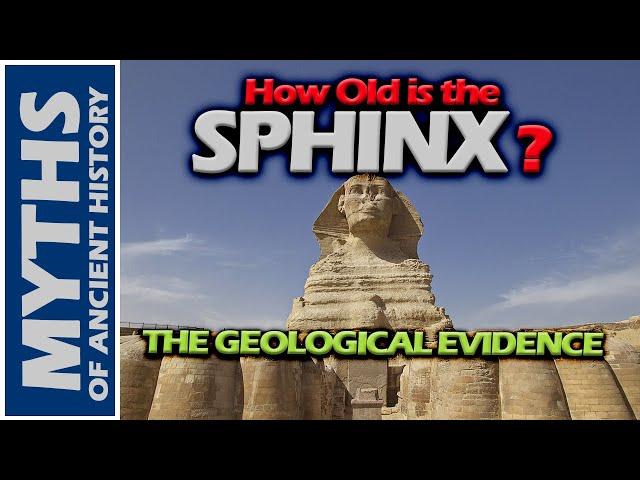
The Age of the Sphinx | Battle of the Geologists
Комментарии:

First, I wish to thank Seyfzadeh for taking the time to comment on my research. I find this improves the quality of my work.
“Schneiker's idea that the Sphinx was made by rough pounding of naturally weak rock, rather than post-creation weathering is based on a fracture seen at the front of the Sphinx, actually not contested by the proponents of rain- and run-off erosion.”
No. My conclusion has absolutely nothing to do with any of the bedrock fractures that cross the Sphinx. I am specifically referring to the surface of the Sphinx body that has been misidentified as erosion by precipitation. The fractures he is referring to were eroded by acidic groundwater long before the Sphinx was carved. This erosion predates the Sphinx and definitely was not produced by precipitation.
There exists a continuing problem of erosion on the side walls of the Sphinx enclosure caused by wicking groundwater. To what extent this has affected the lowest sections of the Sphinx is difficult to say as it has been covered with small repair blocks.
I also suspect Seyfzadeh is speaking for himself, not for proponents of rain- and run-off erosion in general.
“This fissure is mentioned by Lehner in his thesis.”
I suspect Seyfzadeh is referring to the Major Fissure. This fracture, or cave as I call it, was formed as acidic groundwater dissolved the limestone over millions of years. Seyfzadeh is right that Lehner mentions it in his dissertation. Lehner believes the Major Fissure was not discovered until during the construction process. Saying that its discovery is what forced the builders to elongate the Sphinx body, thus making the head appear too small. The Major Fissure is what Anyextee mistakenly describes as a hidden entrance to the Sphinx.
If I understand Seyfzadeh correctly, he believes the erosion of the bedrock fractures occurred following construction of the Sphinx. And that the erosion was caused by precipitation, not acidic groundwater. That is inconsistent with all of the geologic evidence. For instance, Robert Schoch and Thomas Dobeclki identified a weathered limestone beneath the Sphinx as part of a seismic investigation. The presence of a weathered limestone beneath the Sphinx was later confirmed by Lehner in a series of borings constructed as part of a dewatering system installed to protect the Sphinx from wicking groundwater.
“What Schneiker is not showing you is the north and south side of the body where you can still see a whole row of vertical channels, more so on the south side than the north side in keeping with Reader’s model that run-off was more important than rain and that a rain catchment surface is needed to produce the run-off.”
I am not ignoring the fractures. Like Lehner, I am pointing to them, and the evidence contained within them. What Seyfzadeh is not telling you is the “vertical channels” are bedrock fractures. Fractures are produced by tectonic processes, then widened by acidic groundwater. Seyfzadeh needs to look at photographs of the north and south sides of the Sphinx taken prior to the 1920s. He would discover he is wrong about the fractures being more numerous on the south side. Not that this has anything to do with erosion by precipitation or the age of the Sphinx.
“I ask you, is the back of the Sphinx level? Take a look for yourself. Not to me, but I have not been up there to measure if it is.”
Yes, the Sphinx back is nearly level as it follows a geologic bedding plane. There is however, a 5 to 10 degree dip to the south-east at Giza. This dip is obvious to anyone who has ever walked uphill from the Sphinx to the Great Pyramid of Khufu. The dip can easily be seen in any photograph of the Sphinx taken looking towards the west. The geologic beds dip below ground near the Valley Temple, in the south-east corner of the Sphinx enclosure.
“How would Schneiker explain more channels south than north?”
As I already wrote, Seyfzadeh is wrong about there being more fractures on the south side of the Sphinx. I wonder if he is actually referring to the southern wall of the Sphinx enclosure, and not the Sphinx itself. If so he is correct that the southern wall has experienced a greater degree of erosion by salty wicking groundwater. This is because of the bedding that dips to the south-east placing the softer limestone closer to the water table on the south side of the Sphinx enclosure.
If however, the erosion of the Sphinx enclosure was caused by precipitation as Seyfzadeh believes, then the north wall should exhibit a higher degree of erosion than the south wall.
That is unless Seyfzadeh has found a way for water to flow up hill and enter the Sphinx enclosure from the south.
“Regarding Schneiker's idea that the rough-pounded statue was immediately dressed with hewn blocks, where are the oldest ones he proposes except on the lowermost courses?”
Now I am mystified. Seyfzadeh starts his comments by saying he agrees with me. Then questions whether the Sphinx was “immediately dressed with hewn blocks”. This is core to my theory. You cannot have one without the other. Unless he is suggesting the ancient Egyptians left the Sphinx with the rough cut body we see today.
Seyfzadeh is right about the oldest and largest blocks being preserved on the lower sections of the Sphinx. This is not surprising as the Sphinx was buried in sand for most of the past 4,500 years. Protecting the lower blocks from looting. That the blocks have not eroded away is further evidence they were not eroded by precipitation.
“The bulk of the blocks, i.e. the smaller ones, are not from the Old Kingdom. He thinks the blocks were looted. Well then why weren't the smaller ones, the ones easier to carry?”
Seyfzadeh is correct that the bulk of the smaller blocks do not date to the Old Kingdom. It is well documented that they were applied during a series of repairs beginning more than 1,000 years later. This process of repairing the Sphinx with smaller blocks has continued throughout much of the last century. The question is whether the original larger blocks were looted or badly eroded. To answer the question as to why the small blocks were not looted is easy, they have replaced the larger blocks that had been looted.
“Regarding Schneiker's idea that the face of the Great Sphinx is not exact....I encourage you to look at the face of (very young appearing) Khafre on a bust displayed at the Metropolitean Museum of Art.”
I encourage Seyfzadeh to look at the face of the Sphinx again. There is no question that the facial features were adjusted to match the bedding planes.
“I actually differ here from Frank Domingo's facial analysis because he used a model of face of Khafre that must have shown him as an older adult. That's a pretty close match including the still present facial fat pads. Regardless, the face of the Sphinx does not date the whole statue, nor does it falsify the idea of a remodeling job. I think that goes without saying.”
Well put, the face cannot be used to date construction of the Sphinx. Again I suggest Seyfzadeh is speaking for himself and not others such as Schoch and West for whom the face is paramount. Which is why they had Domingo analyze the face in the first place.
As far as a larger head, that is impossible. First because of the limited thickness of the geologic layer from which the head was carved. Second because of the bedrock fractures, “channels” as he calls them, that cross the Sphinx. It was the size of a fracture free natural block of limestone, that became the head. That block determined the overall scale of the Sphinx.
So it does not seem that Seyfzadeh agrees with me after all. For him to truly agree, he needs to agree that there is no erosion by precipitation, on the Sphinx.
I would love to debate Seyfzadeh or anyone who claims the Sphinx is older. I tried with Randall Carlson who agreed to “go toe to toe”, never to be heard from again.
Thanks,
Robert Adam Schneiker, Geologist / Geophysicist, MS, PG

You say "bricks", but you surely mean limestone stones, right?
Ответить
Comparing the Spinx with Goblete Tepe is an UFO-sideline siize these remains are dated by the Turkish government (Erdogan) an scolars willing to work there must agre, Suggestion: Tracy the way this dating was made. I have and, found it to be a hoax.
Ответить
When people believe in god magic they're susceptible to any BS. Guaranteed most believers of conspiracy "archaeology" firmly believe jesus was real and resurrected from death😂
Ответить
The problem with their research is the fact that they are looking at the erosion from the location with a preconceived notion that the date must be in a given range. If they were to locate similar stones eroded in the same fashion they would conclude it takes about 900,000 years to manifest. They need to determine the degree of flat surface and then determine the length of the erosion and then determine how long it takes to erode one inch. Then multiply the time with the length. They will find that every inch takes over 1,000 years and there are several feet of erosion. They are trying to keep the construction within our current civilization which is so wrong. Our civilization did not construct the Sphinx or the pyramids. That is why they cannot tell you how they built the pyramids. How can people build something so magnificent and then forget the technology? Even today we can not level 100 ton granite stones on all eight sides, let alone move them into exact positions. They don't want you to know that the civilization that built all that is long gone and we will be also one day. They are sticking to the story that we are the only people that ever lived on earth and they build the pyramids with ropes and cooper tools. The quarry was over 500 miles away!!! How are you going to drag 100 ton stones across the desert with a rope!!!!!!!!!! Tell these people to shut up and say they have no idea what happened and the entire area is at least 900,000 years old.
Ответить
I don't know if I said this to you before on this video. BUt I have come back several times to watch it (after watching what I call "Goober-Historians", and the specials that they have made. And every time, this video is the only one that makes sense to me. THANK YOU!!!!
Ответить
He moved the date back bc of evidence for a cataclysm, he thinks it is bc of the sun as well as seeing that it would be lined up with Leo in the stars around that time. So, no it wasnt bc of geological evidence but bc of that and probably core samples which can give him further information on when the water erossion could have occured.
Ответить
The best thing I can say is, if you haven’t seen it live you should do so.
The vast majority of people are laymen, like me, and have no idea what the age of the Sphinx is but when you’re standing looking at it with the backdrop of the pyramids around you, it doesn’t matter.
Go see for yourself.

The pyramids were powerplants. Its obvious.
Ответить
Hello - The Sphinx is in fact 6,5 million years old.
Ответить
First why in the middle of a desert or a lush green forest why a king would build spinx?
What's the reason behind it?
Or what was there before giza pyramad?
Was there a temple existed well before pyramid built?
All these tr questionable and geologist still not finding any ans for it

Hello - The Sphinx is in fact 6 million years old. Best wishes.
Ответить
Are there any other statues in Egypt made in the same manner as the Sphinx? Another statue where they carved it out of the bedrock below ground level?
BTW If that theory about the erosion being present BEFORE excavation had started was true, wouldn't that mean the Sphinx itself would have been a horrible statue? If they saw the low quality of the stone, would they have really risked carving a neck and head?

King Khufu quarried the limestone around the Sphinx?
Ответить
I understand that the Sphinx was carved prior to it was weathered.
The Sphinx carved out of the limestone Mokkatam Formation. Where are the rest of the limestone around the Sphinx? Heavily eroded and deep?

The plain truth is, WE DON'T STILL KNOW how old it is, because it is made of ... STONE !!!! So, the rest is pretty much ... huh .... circumstantial evidence ??? NOBODY knows, but one thing is for sure, mainstream academia has been wrong quite a few times before
Ответить
So what was sitting in the enclosure before the sphinx?
Ответить
“…and so there you have it kids. Once again my opinion coupled with SCIENCE has single-handedly saved 150 years of Egyptology “! 🙇♀️ 🙇♀️
Ответить
The guy who was on The Joe Rogan show you can throw anything he says away. No quality good respectable person would go on Joe Rogan
Ответить
So to be clear, now the Accademics are saying that the Water erosion on the Sphinx enclosure occured before they carved out the body?
And that the ancient Egyptians could not carve or "pound" a perfect body and had to compensate by adding bricks? I am sorry but this starts to sound like Hancock's theories here.

My question would be if the same argument would exist if it wasn't the Sphinx at the center of it but just a random rock pile? Otherwise Schneiker's theory is in fact the least logical to me especially his belief the same people who apparently were able to build the pyramids (don't get me started) were then hindered by the existing contours of the rock on the head of the Sphinx to make a shape not representative of a particular Pharaoh. That's funny.
Ответить
No, this is bullshit, every serious geologist knows this, stop foolling people
Ответить
Another great video. This channel and it's host are very scientifically reliable.
Ответить
The intonation of your voice based on the scientist and theory clearly shows which theory you’re biased towards
Ответить
If a person has an open mind, he considers all sides.
this video proves it.

good arguments
Ответить
I want someone to study the acid rain theory of GEOFFREY DRUMM.
Ответить
Good video. I still think the theory of the Sphinx being weathered by rain, making it much older than originally believed is the strongest theory.
Ответить
The thought that the water wicking up and fracturing a roughly sphinx-shaped bit of rock in an area used for a quarry later makes several of the competing theories agree, doesn’t it?
The poor buggers cutting stone from the quarry that would later be the sphinx enclosure suddenly hitting that weak spot and sloughing off the stone on one side of the fracture probably got one heck of a startle out of it and then saw a roughly sphinx-shaped mass of unusable stone right in the middle of their quarry. That would have led to a “well shit” moment in construction history like no other. It could very well be that it was easier to make use of that mass of unsuitable stone to make some sort of sculpture than to haul it off. It may have been a happy accident four thousand years before Bob Ross would even be born.
The one thing you never hear about in monumental architecture is what the builders do when something goes horribly sideways. The unique nature of the sphinx has always made me wonder if it was something that wasn’t an intentional part of the design. A 60’ long mass of stone that looks like it is crumbling and won’t hold weight sure looks like something that went horribly wrong to me.
Schoch changes his date every time something older is discovered. If a ring of standing stones was discovered tomorrow that dated to 30k years ago, the sphinx would suddenly be 30k years old in his estimates. His association with both the ancient alien and ancient high-tech civilization crowd makes me dismiss pretty much anything he says until someone else corroborates it.

Astronomical evidence?
Ответить
Why would you carve the head but brick the body? Don't understand this part.
Ответить
Over 12 thousand years old
Ответить
So just making stuff up. As a debunk. Hmmm.
Ответить
That tiny sphinx head looks ridiculous
Ответить
I know that the only way we'll get exact real answers everyone will except is a separate group of scientists from several fields do a new in depth study, including investigating underneath the bricks. The bricks may be able to date. They're made from clay and straw. I'm sure scientists can come up with other ways to date it
Ответить
Very enjoyable.
Ответить
Why on earth had proper scientists not done all this research 🔬 DECADES AGO?!?! 🧐
40 years ago, as a child, I knew scientists 👩🔬 needed to do studies.
It would squash all the mystery and interest.
Which is why Egypt 🇪🇬 has not wanted it done. That mystery and interest generates a lot of money.
I may be a scientist 👨🔬 at heart. But it’s still sad to see The Easter Bunny die. 😞

The assertion that thousands of archaeologists and academics are purposely lying and hiding the fact that it’s actually much older is the stupidest theory ever….. any archaeologist who has spent years in the field would be desperate to make a giant discovery like this, most of these guys aren’t famous or making big money, it would make your career to prove this stuff.
Ответить
Who knows what lies underneath the huge/massive dunes of the Sahara. Our understanding of human history may be distorted.
Ответить
I cant wait to see it
Ответить
Christensen is full of it
Ответить
I believe that the body would have been fairly smoothe. Why would the sculptors do an uneven carving, knowing that they must smoothe it up using stones. Double work. Also, the face was changed. That's why the face is not so much weathered. There are so many guessing, theories and ideas, but we still don't know ! The sphinx is definitely older than 10 thousand BC. I have my own idea : Aliens assisted with the building of the pyramids and sphinx. No one can say aliens didn't ! We just don't have a clue !
Ответить
While the idea of the sphinx being originally covered in brickwork makes a lot of sense, it presents a few problems for me. Assuming that the ancient Egyptians did indeed go with the method of only roughly cutting the body and covering it in brick (by brick I mean cut stone with the appearance of brickwork, and not sundried mudbrick or fired brick like the mesopotamians), it means that the irregular space between the brick and the rough worked body needed to be filled in order to keep the bricks in place. The ancient Egyptians did have mortar that could accomplish this. But that's a problem because I haven't heard of any such mortar being found at the site. Moreover if there were some that would be good news because ancient Egyptian mortar often contained charcoal and thus could be radiocarbon dated. That's how we know for certain how old the pyramids are because they have such mortar to bind the stonework together.
The other thing I wanted to mention is the head. It's a single intricately carved piece the native stone. Assuming the brickwork happened that means there had to have been a transition zone, which I don't think I've seen. Moreover there is the disproportionately small head compared to the body. I know it doesn't necessarily mean it was something else earlier and remodeled, but it doesn't rule it out either.

Rediculous
Ответить
Clearly the Sphinx was built 6000 years ago by the evil scientist Yakub using tricknology, shortly before realizing his master plan to create the albinoid race
Ответить
If the body was rough cut, why wouldn’t they make it in proportion to the head?
Ответить
Great episodes. A rough inner core with brick finish all over makes so much sense and is consistent with how pyramids were built. Occam's razor at work 😊
Ответить
It does seem to make an aesthetic sense that the Giza plateau funerary complex would have a collective type of fascia, bricks, on all of the larger monuments. To my mind, while the Ancient Egyptians were obsessed about the afterlife, those of nobility and power anyway, there are design motifs throughout the various dynastic periods that have wholesale design strategy and implementation.
I think that maybe the "alternative or pseudo" scientific theories have blindsided everyone, up until this recent theory. Kind of obvious now it's out there. Great video!
I don't go anywhere else for top drawer factual, evidence based and rational discussion of all things ancient. There may be a few others, but I'm very happy to have found your channel. Thank you.

This is what makes it so hard to just trust the science. The he science doesn’t know, but they can’t just say they don’t know, everyone has to give their personal theory whether supported by evidence or not. What matters in the end isn’t WHAT is right, it’s WHOM is right.
Ответить

























